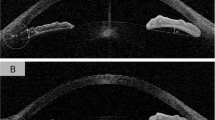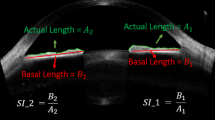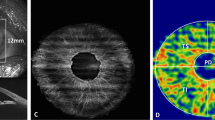Abstract
Purpose
To determine the associations between the demographic factors (age and sex) and physiological dynamic iris changes and explore the associated factors for iris cross-sectional area (IA) change in healthy Chinese individuals.
Methods
This cross-sectional study included individuals aged ≥40 years with an open angle and underwent anterior segment optical coherence tomography under light and dark conditions from the follow-up cohort of the Handan Eye Study. Ocular data from the right eye were analyzed. The Pearson correlation coefficient was used to assess the relationship between age and iris parameters, including iris thickness (IT), IA, and iris curvature (IC), as well as the pupil diameter (PD) in the dark, and their changes from light to dark conditions. Linear regression analysis was performed to identify the potential factors associated with IA change.
Results
The final analysis included 465 healthy individuals. PD in dark, IA change and PD change decreased with age (P < 0.001), whereas IC increased with age (P < 0.001). IT and IT change were smaller, and IC was larger in women than that in men (P = 0.021, 0.007, and 0.010, respectively). Older age (P = 0.041), larger lens thickness (P = 0.013), larger IC change (P < 0.001), and smaller PD change (P < 0.001) were significantly associated with a smaller IA change.
Conclusions
Our study demonstrated the associations of static and dynamic iris parameters in healthy Chinese individuals. The findings provided a possible explanation for the higher prevalence of primary angle closure disease in elderly and female populations.
This is a preview of subscription content, access via your institution
Access options
Subscribe to this journal
Receive 18 print issues and online access
$259.00 per year
only $14.39 per issue
Buy this article
- Purchase on SpringerLink
- Instant access to full article PDF
Prices may be subject to local taxes which are calculated during checkout


Similar content being viewed by others
Data availability
The authors declare that all data supporting he findings of this study are available within the paper. They are not publicly available, and restrictions apply to their use. All requests would require evaluation on an individual basis and can be made by contacting wningli@vip.163.com.
References
Wang BS, Narayanaswamy A, Amerasinghe N, Zheng C, He M, Chan YH, et al. Increased iris thickness and association with primary angle closure glaucoma. Br J Ophthalmol. 2011;95:46–50.
Wang B, Sakata LM, Friedman DS, Chan YH, He M, Lavanya R, et al. Quantitative iris parameters and association with narrow angles. Ophthalmology. 2010;117:11–7.
Zhang Y, Li SZ, Li L, He MG, Thomas R, Wang NL. Quantitative analysis of iris changes after physiologic and pharmacologic mydriasis in a rural Chinese population. Invest Ophthalmol Vis Sci. 2014;55:4405–12.
Zhang Y, Li SZ, Li L, He MG, Thomas R, Wang NL. Quantitative analysis of iris changes following mydriasis in subjects with different mechanisms of angle closure. Invest Ophthalmol Vis Sci. 2015;56:563–70.
Zhang Y, Li SZ, Li L, He MG, Thomas R, Wang NL. Dynamic iris changes as a risk factor in primary angle closure disease. Invest Ophthalmol Vis Sci. 2016;57:218–26.
Nonaka A, Iwawaki T, Kikuchi M, Fujihara M, Nishida A, Kurimoto Y. Quantitative evaluation of iris convexity in primary angle closure. Am J Ophthalmol. 2007;143:695–7.
Sun X, Dai Y, Chen Y, Yu DY, Cringle SJ, Chen J, et al. Primary angle closure glaucoma: what we know and what we don’t know. Prog Retin Eye Res. 2017;57:26–45.
Invernizzi A, Giardini P, Cigada M, Viola F, Staurenghi G. Three-dimensional morphometric analysis of the iris by swept-source anterior segment optical coherence tomography in a Caucasian population. Invest Ophthalmol Vis Sci. 2015;56:4796–801.
Narayanaswamy A, Zheng C, Perera SA, Htoon HM, Friedman DS, Tun TA, et al. Variations in iris volume with physiologic mydriasis in subtypes of primary angle closure glaucoma. Invest Ophthalmol Vis Sci. 2013;54:708–13.
Sng CC, Allen JC, Nongpiur ME, Foo LL, Zheng Y, Cheung CY, et al. Associations of iris structural measurements in a Chinese population: The Singapore Chinese Eye Study. Invest Ophthalmol Vis Sci. 2013;54:2829–35.
Soh ZD, Thakur S, Majithia S, Nongpiur ME, Cheng CY. Iris and its relevance to angle closure disease: a review. Br J Ophthalmol. 2021;105:3–8.
He M, Lu Y, Liu X, Ye T, Foster PJ. Histologic changes of the iris in the development of angle closure in Chinese eyes. J Glaucoma. 2008;17:386–92.
Konstas AG, Marshall GE, Lee WR. Immunocytochemical localisation of collagens (I-V) in the human iris. Graefes Arch Clin Exp Ophthalmol. 1990;228:180–6.
Seet LF, Narayanaswamy A, Finger SN, Htoon HM, Nongpiur ME, Toh LZ, et al. Distinct iris gene expression profiles of primary angle closure glaucoma and primary open angle glaucoma and their interaction with ocular biometric parameters. Clin Exp Ophthalmol. 2016;44:684–92.
Lin J, Wang Z, Chung C, Xu J, Dai M, Huang J. Dynamic changes of anterior segment in patients with different stages of primary angle-closure in both eyes and normal subjects. PLoS ONE. 2017;12:e0177769.
Zheng C, Cheung CY, Aung T, Narayanaswamy A, Ong SH, Friedman DS, et al. In vivo analysis of vectors involved in pupil constriction in Chinese subjects with angle closure. Invest Ophthalmol Vis Sci. 2012;53:6756–62.
Quigley HA, Silver DM, Friedman DS, He M, Plyler RJ, Eberhart CG, et al. Iris cross-sectional area decreases with pupil dilation and its dynamic behavior is a risk factor in angle closure. J Glaucoma. 2009;18:173–9.
Liang YB, Friedman DS, Wong TY, Wang FH, Duan XR, Yang XH, et al. Rationale, design, methodology, and baseline data of a population-based study in rural China: the Handan Eye Study. Ophthalmic Epidemiol. 2009;16:115–27.
Cao K, Hao J, Zhang Y, Hu AL, Yang XH, Li SZ, et al. Design, methodology, and preliminary results of the follow-up of a population-based cohort study in a rural area of northern China: Handan Eye Study. Chin Med J. 2019;132:2157–67.
Sakata LM, Lavanya R, Friedman DS, Aung HT, Seah SK, Foster PJ, et al. Assessment of the scleral spur in anterior segment optical coherence tomography images. Arch Ophthalmol. 2008;126:181–5.
Console JW, Sakata LM, Aung T, Friedman DS, He M. Quantitative analysis of anterior segment optical coherence tomography images: the Zhongshan Angle Assessment Program. Br J Ophthalmol. 2008;92:1612–6.
Wang D, He M, Wu L, Kao A, Pekmezci M, Singh K, et al. Dark-light change of iris parameters and related factors among American Caucasians, American Chinese, and Mainland Chinese. Curr Eye Res. 2012;37:599–605.
Chua J, Seet LF, Jiang Y, Su R, Htoon HM, Charlton A, et al. Increased SPARC expression in primary angle closure glaucoma iris. Mol Vis. 2008;14:1886–92.
Chung C, Dai M, Lin J, Wang Z, Chen H, Huang J. Correlation of iris collagen and in-vivo anterior segment structures in patients in different stages of chronic primary angle-closure in both eyes. Indian J Ophthalmol. 2019;67:1638–44.
Jouzdani S, Amini R, Barocas VH. Contribution of different anatomical and physiologic factors to iris contour and anterior chamber angle changes during pupil dilation: theoretical analysis. Invest Ophthalmol Vis Sci. 2013;54:2977–84.
Chua J, Thakku SG, Tun TA, Nongpiur ME, Tan MC, Girard MJ, et al. Iris crypts influence dynamic changes of iris volume. Ophthalmology. 2016;123:2077–84.
Valmaggia P, Inglin N, Kaiser P, Scholl HPN, Maloca PM. Iris color matters-a contractility analysis with dynamic volume-rendered optical coherence tomography pupillometry. Transl Vis Sci Technol. 2022;11:6.
Funding
This study was supported by the General Program of National Natural Science Foundation of China (Grant Number 82371050), the Research Special Fund of the Ministry of Health of the People’s Republic of China (Grant Number 201002019), the Beijing Hospitals Authority Youth Program (Grant Number QML20210201) and the General Program of National Natural Science Foundation of China (grant number 82371050). The funding organization had no role in the design or conduct of the study.
Author information
Authors and Affiliations
Contributions
NLW and YZ contributed to the design, acquisition of funding, and general supervision of the research group. JW and TTL contributed to the design, results analysis, and manuscript drafting. SZL contributed to the data collection. MGH and XFW contributed to the manuscript revision. All authors reviewed and edited the manuscript and approved the final version of the manuscript.
Corresponding authors
Ethics declarations
Competing interests
The authors declare no competing interests.
Additional information
Publisher’s note Springer Nature remains neutral with regard to jurisdictional claims in published maps and institutional affiliations.
Supplementary information
Rights and permissions
Springer Nature or its licensor (e.g. a society or other partner) holds exclusive rights to this article under a publishing agreement with the author(s) or other rightsholder(s); author self-archiving of the accepted manuscript version of this article is solely governed by the terms of such publishing agreement and applicable law.
About this article
Cite this article
Wang, J., Liu, T., Li, S. et al. Associations of static and dynamic iris parameters in healthy Chinese individuals: the Handan Eye Study. Eye 38, 3504–3510 (2024). https://doi.org/10.1038/s41433-024-03345-1
Received:
Revised:
Accepted:
Published:
Issue date:
DOI: https://doi.org/10.1038/s41433-024-03345-1



